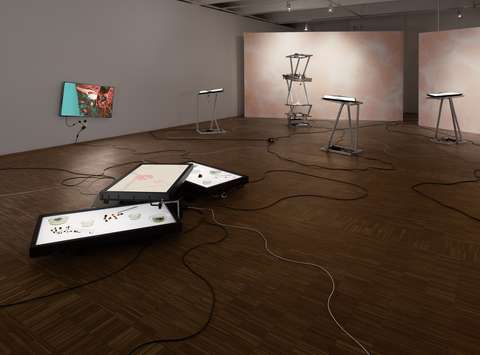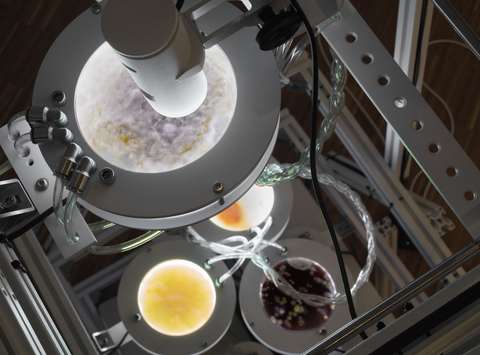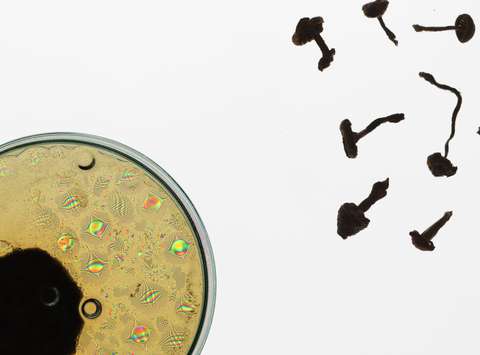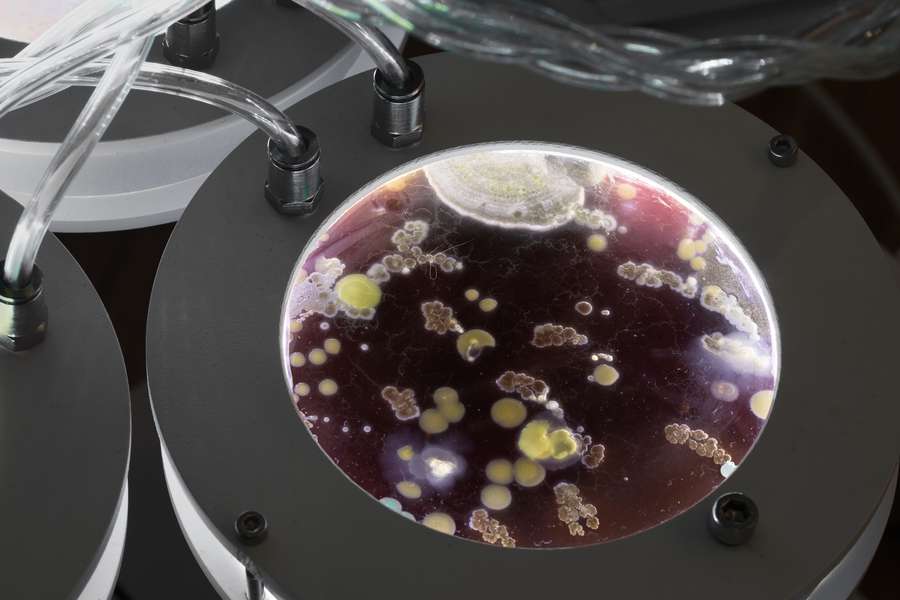Saša Spačal
MycoMythologies
In her work, Saša Spačal primarily explores the entanglement of nature and culture, focusing on how all changes are embedded in an infinite number of micro and macro feedback loops, driven by the metabolism of microorganisms, which are invisible to the human eye.
In this instance, with the ongoing series MycoMythologies (2020–) that so far consists of two biotechnological installations, a video essay, and a performative workshop, she ventures underground to explore the fungal mycelium, which is the vegetative part of fungi that not only interconnects individual trees by transferring water, nitrogen, carbon, and other minerals between them but also constitutes their communication system.
The installations narrate stories that are taking place in two nodes of the currently dysfunctional world techno-mycelium network. MycoMythologies: Rupture is a biomimetic myocentric network with a central node in a microscope connected to a computer vision program. While the surrounding mythmaking screens show the extraction of mushrooms from their environment, the microscope travels across the mycelial nets. With every motion detection in the hypha, the computer vision triggers a sound and different voices repeating the phrase “We can’t return to normal because the normal that we had was precisely the problem.” The movement of a nutrient particle simultaneously causes a change in the circulation of images, which is performed by the network’s algorithm in the same way that the mycelium decides where to send nutrients.
If the first installation can be understood as an indicator of a networked world in crisis, with voices calling for change, new stories, and new ways of thinking, MycoMythologies: Patterning already develops proposals and methods to overcome pressing circumstances by establishing a dialogue with the mushroom ecosystem. This biotechnological audio-visual installation shows a growing fungal colony of a Lion's mane mushroom (Hericium erinaceus), which is being contaminated through braided air tubes by the artist's own microbiome derived from blood, sweat and tears. The artist renders and sonifies the growth of the human-animal hybrid landscapes in real time. Using a microscope and computer vision, three screens show the process of mapping based on changes in the colour and texture of the colonies and, after the microscopic maps are processed, gathers them in the database of the Atlas of Collaborative Contamination. With this installation, the artist shows the material interconnectedness of the living and the non-living world and offers us contamination as a possibility for a productive exchange between different forms of life.
The video essay MycoMythologies: Infrastructures for Each Other combines human and mycelial components as well as algorithms to reflect on interspecies infrastructures as supporting elements of an ecosystem. Whether they are the achievements of humanity or of other living entities, they are interlinked either because of physical contact or because the designs of our devices and objects are often derived from biological creations.
In her series MycoMythologies, Spačal uses the method of narrating myths, which are not just stories, but are always connected to practices, rituals, and repetitions. She uses them because they can be embedded with ethical considerations. The series thus acts as a testing ground for change, allowing us to go beyond the techno-deterministic predictions and end-of-the-world scenarios of the Anthropocene. In addition to concepts such as inclusion, empathy, and care for the Other, the artist further introduces a polyphony of voices that serve as a metaphor for the fact that there is no clear and simple solution to the current circumstance.
Colophon
Artist: Saša SpačalExhibition curator: Alenka TrebušakText: Alenka TrebušakProgramming, computer vision: Matic PotočnikSound, software design: Pim Boreel, Saša SpačalMicrobiology, technical support: Mirjan ŠvageljVideo footage: Tilen SepičVoice: Polona TorkarSong: Kaitlin Bryson, Saša SpačalStyleGAN: Kaitlin Bryson, Matea FriendMycelium micrographs, technical support: Toby Kiers Laboratory [Vrije Universiteit Amsterdam]Suppport: Projekt Atol, MGML, KID Kibla, PIF Camp, Zone2Source, Amsterdams Fonds voor de Kunst, Toby Kiers Laboratory [Vrije Universiteit Amsterdam], Ministry of Culture of Republic of SloveniaDesign: Ajdin BašićRealisation of the exhibition: Technical Service MGMLThe exhibition was made possible by: City of Ljubljana
Location
Tobačna ulica 1
1000 Ljubljana
Information and reservations:
T +386 1 24 12 500
T +386 1 24 12 506
E prijava@mgml.si
Opening hours
Exhibition space is open according to exhibitions:
Tuesday–Friday: 11:00–19:00
Monday, Saturday, Sunday: Closed
Tickets
Free entry.
Press kit





